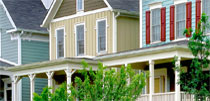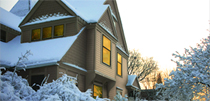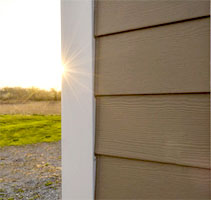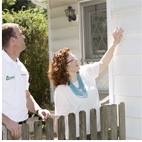by Miguel Guzman
4/11/2022

Head outside with this spring home maintenance checklist to give your home a thorough inspection to identify any exterior home maintenance that may need to be addressed.
1. Roof
What to look for: From the vantage point of your lawn (using binoculars, if you have them), scan for missing shingles, as well as curling and “cupping” shingles, which can slow water run-off, trap moisture, and accelerate wear. Also look at penetrations in the roof—at the chimney and plumbing vent, for instance—to make sure flashing lays flat and is rust free. On your home’s north and east sides, where there is less sun, watch for mold and moss.
What to do: Because roof maintenance is potentially dangerous work, hire a roofer to repair and replace shingles. Call a handyman to fix flashing or to clean moss and mold, which can make a roof slick.
2. Windows
What to look for: Spring is the perfect time to give windows a deep cleaning. It’s also when to investigate window frames for peeling paint and rot.
What to do: To determine whether a wooden window frame is rotting, press into it with your fingernail. If the wood is soft enough to give, it’s time to visit the hardware store for a product that can fix it—or to call a window company about replacement options.
3. Siding
What to look for: Winter weather can leave dirt and debris on siding, which often benefits from a spring cleaning.
What to do: Refer to our guide on how to clean siding for helpful pointers. And remember: It may be tempting to use a power-washer, but it’s also easy to go overboard. A garden hose, soft brush, and mild cleaner will usually do the trick.
4. Gutters & Downspouts
What to look for: Examine gutters and downspouts for large blockages of leaves, pine needles, or stray baseballs. To locate hidden clogs, go outside when it’s raining: If water pours over the top of a gutter, it’s blocked. Be sure water flows freely from downspouts too.
What to do: If you have a one-story home and feel comfortable on a ladder, you may decide to clean gutters and downspouts yourself (with caution, of course). Otherwise, it’s best to hire a handyman.
5. Deck
What to look for: Because it is exposed to the elements 24-7, even the best-maintained deck will experience some deterioration. Survey a deck’s edges for rotting. Don’t forget to peek underneath for hidden rotting and rusted fasteners or hangers.
What to do: Reference our deck maintenance checklist for details on how to restore and maintain a deck. For minor repairs, visit your local hardware store to buy new fasteners and to find products that can help eradicate rot. Call a handyman or contractor if parts of your deck need to be replaced.
6. Landscaping, Trees & Shrubs
What to look for: Foliage that is too close to the house creates a pathway for pests, so you’ll want to check the distance between your home’s exterior walls and trees and shrubs. Also look at soil, mulch, and landscaping near your home’s foundation. It should slope down and away from the house, so that water doesn’t pool and cause leaks.
What to do: Trim branches and shrubs that are too close to your home, and adjust landscaping as needed to address pooling water. Looking to spruce up your home's current landscaping? Look to our tree tips to boost your home's curb appeal.
7. Chimney
What to look for: Inspect a brick chimney for deterioration, loose mortar, and flaking or “spalling” bricks, all of which are signs that the chimney needs repair. The chimney top or “cap,” typically made of concrete or metal, should be secure and free of cracks that can cause leaks.
What to do: Contact a brick mason to repair a brick chimney. For general chimney repairs or cleaning, search the National Chimney Sweep Guild directory to find a local pro.
8. Foundation
What to look for: Not every crack spells trouble for a foundation, but a crack with deflection might. You can tell when a crack has deflection if it veers in opposite directions or feels bumpy to the touch.
What to do: Get in touch with a concrete or foundation repair company to fix most foundation cracks. Severe cracking, however, may require a consultation with a structural engineer.
When in doubt about any item on your home maintenance checklist, consider reaching out to a certified home inspector. An inspector can provide an unbiased, professional assessment about exterior home maintenance.
And with that, your spring home maintenance checklist is complete. Now you can enjoy all that spring has to offer!
Thank you to Frank Lesh of the American Society of Home Inspectors for sharing expertise for this article.





































